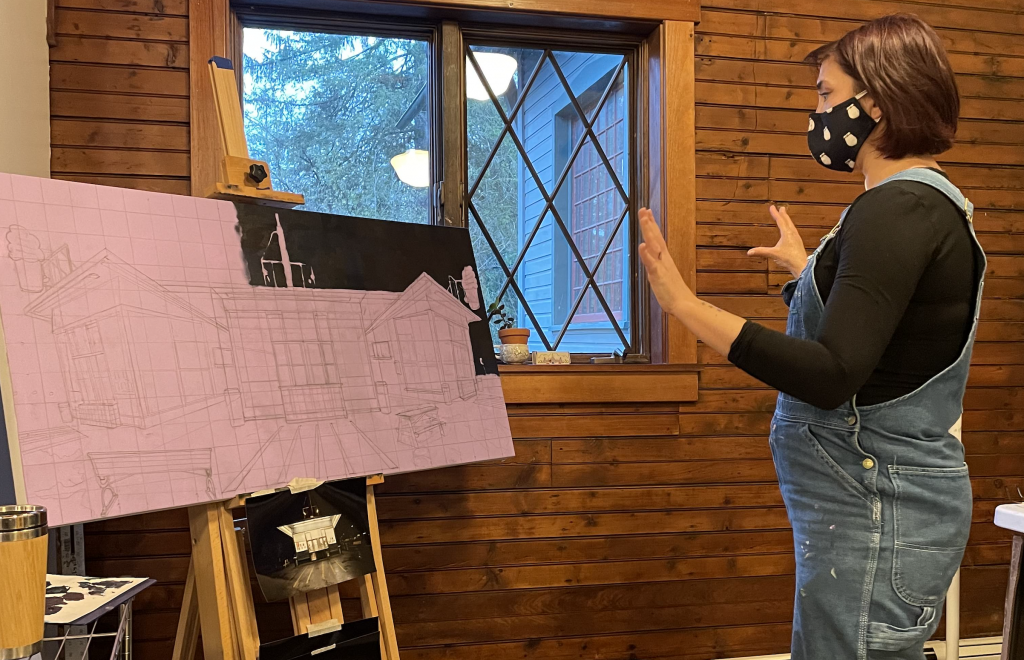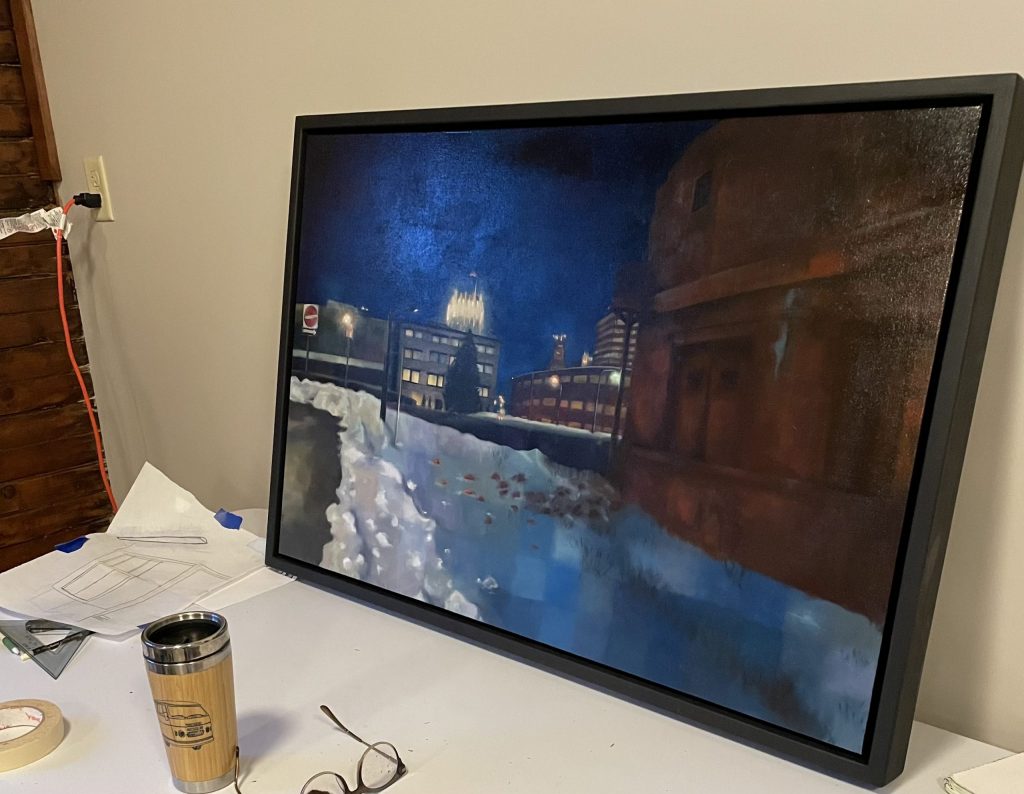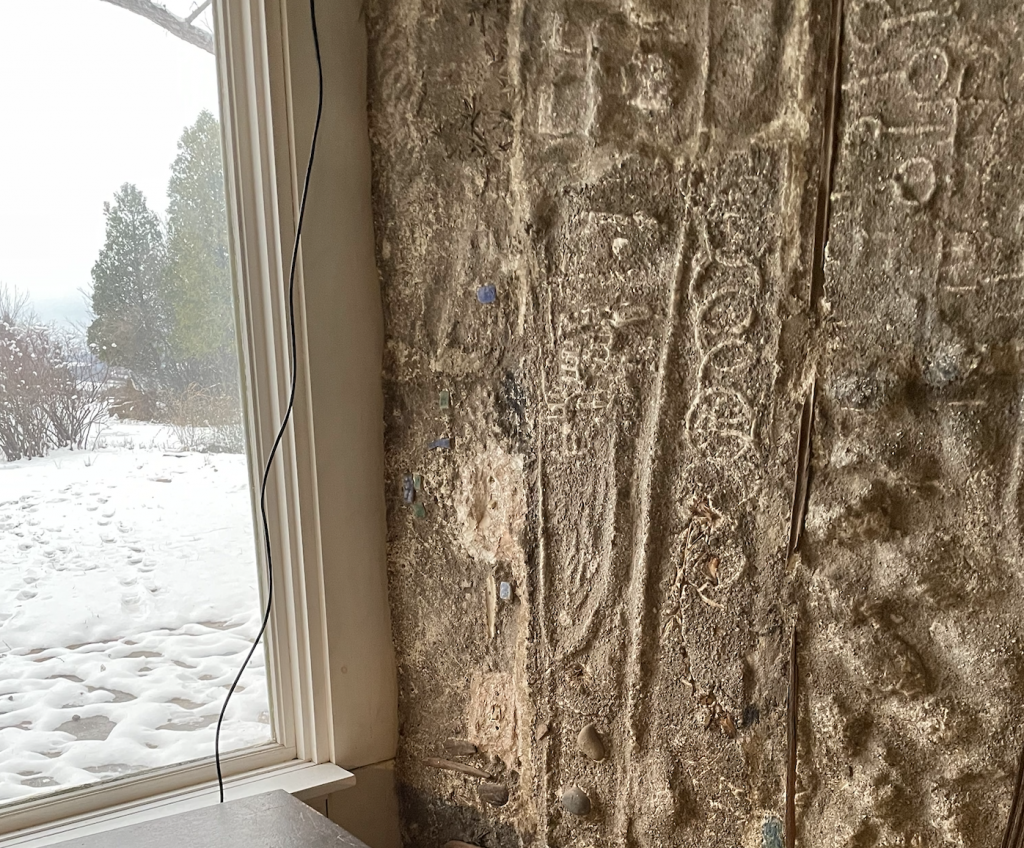Where light comes through: artist Sarah Tietje-Mietz
Artist Sarah Tietje-Mietz discusses painting and returning to Syracuse

When Sarah Tietje-Mietz talks about her paintings, her fingers curl and uncurl as if itching for a paintbrush. Perched on a stool in her Lakeland Park studio in Cazenovia, she’s wearing a black shirt underneath paint-freckled overalls. Her hair is purpley-red, the color only noticeable when it catches the light. She gazes at her current work in progress — a study of three different views of an ice cream stand in Manlius — with tenderness.
It’s a mid-November evening, and the overcast sky erupts with the first snow of the season. There’s a dark wood building across the street, speckled with glowing windows that pierce through the blowing snow. Tietje-Mietz tells me that it’s called the Brae Loch Inn, and that she used to work there. She knows the area well, having grown up in Cazenovia.
We walk along the gravel path to Tietje-Mietz’s studio as the iron-gray waves of Cazenovia Lake lash against the shore. The fast-falling darkness is pitiless, but her studio, housed in an old wooden structure original to the town’s founders, swells with brilliant overhead lights.
When Tietje-Mietz speaks about her many passions, she grows animated. Her eyes glimmer and words trip over themselves, swelling to an inarticulate crescendo. Her first solo art show was in an old church in New Woodstock, and the fact that her studio is in another historic building enthralls her. “Any historic building that I get to do art in, I’m like, ahhh!” she gushes, unable to find the words to express her delight. “It’s historic preservation! Art! Storytelling! All coming together!”

Before we met, Tietje-Mietz had to walk her rescued American bulldog, Badger. “She is filled with tons of baggage and anxiety. I mean, aren’t we all?” Tietje-Mietz laughs. She’s happy to share plenty of pictures of Badger, who sits like a human sometimes. Tietje-Mietz’s now-husband Ralph adopted Badger early in their relationship, about seven years ago.
Tietje-Mietz just returned from taking down her second solo show at the Cape Cod Cultural Center. Her paintings are a series of buildings at night, with radiant windows, strings of bulbs and neon signs illuminating the darkness. Her work is concerned with transformation, the way a city blanketed by night shifts and blurs, the act of creating itself as a form of transformative magic. She also possesses a reverence for sameness, loving the histories and lives that people create within four walls. When I ask if she believes in ghosts, she answers yes without hesitation.
“It’s like memories,” Tietje-Mietz says; for our second conversation, we meet in the Hilltop House and Studio at Stone Quarry Hill Art Park, where Tietje-Mietz is the director. The house and the land surrounding it belonged to mid-century artist Dorothy Riester and her husband. “Every time I come into this house, I say hi to Dorothy and Bob. I don’t believe they’re like, right here with me right now, but I think there’s definitely a sense of them here.”
Tietje-Mietz gushes about the mid-century marvel of Hilltop House–its angled rooftop and the abundance of windows create an intimate connection with nature. She speaks with equal rapture about Dorothy. “Creating was compulsory for her, and there was no definition between her studio practice and her domestic life. They bled into each other,” Tietje-Mietz explains. Dorothy sculpted into the walls, creating an impression of plants and bones and perhaps even creatures trapped in the stone; it’s eerily beautiful.

A Syracuse University alum, Tietje-Mietz graduated from Newhouse’s Goldring Arts Journalism master’s program in 2o2o. She took an unusual approach to completing the yearlong program, stretching it over two years while working full time at the art park. When applying for the program and the job, she didn’t expect to get both. She initially spoke to Goldring program director Eric Grode to decline her admission. Tietje-Mietz was a competitive applicant with a brilliant mind, Grode says, and he was motivated to make the program work for her. “I remember saying to her on the phone, ‘we don’t want to let you go without a fight,’” he recalls.
Molly Demeulenaere, managing director of the Cape Cod Cultural Center, helped Tietje-Mietz put together her show there. Demeulenaere fondly describes working with her as “a dream.” The two of them bonded over their shared love of mid-century architecture. “The way [Sarah] uses lighting in her pieces is really intriguing, and it draws people in,” Demeulenaere says.
Tietje-Mietz paints based on a grid technique she learned earning her fine arts degree at the Art Institute of Boston. She begins by mapping out a grid over the entire canvas, and paints each square meticulously, challenging herself to change the color or tone of the paint at every intersecting line. “It creates this beautiful, sparkling depth that a flat plane of dark blue would not have for a night sky,” she explains.
While working on her first master’s degree in historical preservation, Tietje-Mietz completed a printmaking course at Anchor Graphics, a nonprofit fine art press. After finishing that program, she felt compelled to continue making art. The next step was retrieving her old oil paints and rediscovering her love of the medium, inspired by the photographs of her city at night.
“I decided to challenge myself to capture the glow of the lights in the night, and capture how I felt walking a city street at night…the magical elements that produce when night falls,” Tietje-Mietz says. “Edges blur. Things are not quite solid and a little bit soft at the edges. And it’s theatrical, it’s beautiful, it’s almost magical.”
The buildings in her paintings brim with memories. An old lake house where generations of her family summered. A storefront in Rome from when her mother took her to Italy to help Tietje-Mietz heal from a disintegrating relationship. A view of downtown Syracuse laden with snow, which she describes as the city she fled from before realizing its beauty and returning. “It’s an act of re-experiencing those emotions and memories, each time I work on that project. It’s a reliving in every single sense of it,” Tietje-Mietz muses.
Sipping from a thermos, Tietje-Mietz drinks her coffee black. “It’s my only lasting addiction,” she says lightly. “Give me one! I don’t drink anymore, I don’t smoke cigarettes anymore, but give me my coffee!” She’s sober four years this Thanksgiving. “I have to say, these four years have been some of the best four years of my life. And they’ve been some of the hardest because I’ve had to feel everything. I couldn’t run from any of my emotions.”
Tietje-Mietz has difficulty expressing her artistic process. Beyond the practicalities of the grid system, there’s something about the act of creation that eludes language. She’ll finish a painting, not knowing how it happened. “Making art is like alchemy,” she says. “You take one thing, and it’s completely transformed through science and magic into something completely else, and it’s like gold.”





